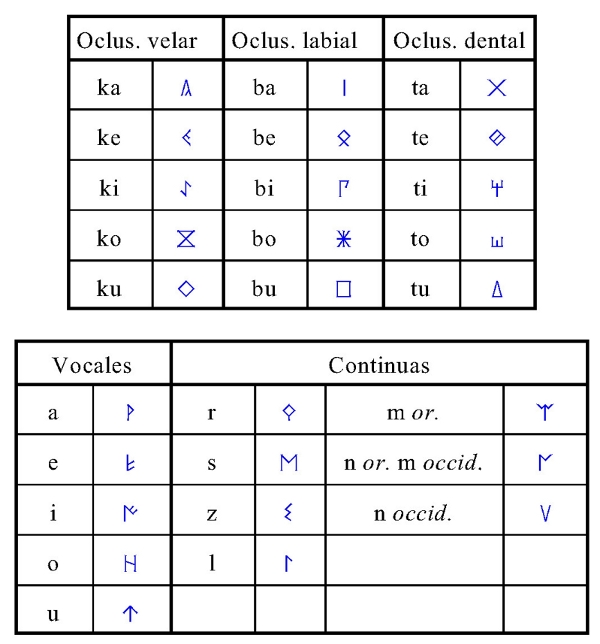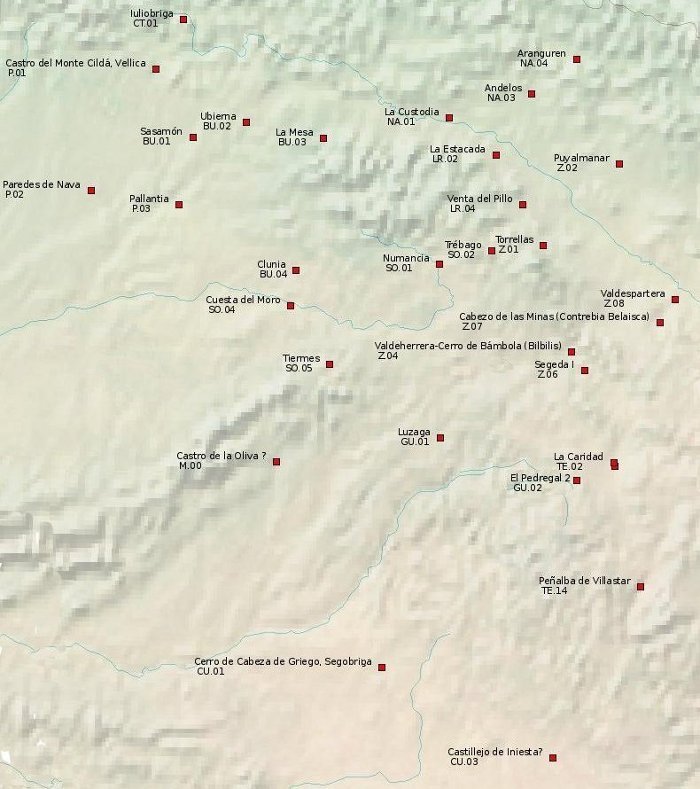Celtiberian
Access to the Celtiberian Data Bank
This section includes Celtiberian inscriptions in the strictest sense, that is, those whose language we can identify as Celtiberian because of the phonetic or morphological features the inscriptions demonstrate, and also inscriptions in Celtiberian territory whose language is impossible to determine with any certainty, whether due to their fragmentary character or the brief nature of the inscription (as typically happens with graffiti and other marks on ceramics). The Celtiberian language is an Indo-European language which belongs to the Celtic family (like Irish, Welsh, Breton, etc.), in the same way as other languages for which we have testimony in Antiquity, essentially Gaulish and Lepontic. With a few minor exceptions, the known Celtiberian inscriptions to date were published and studied by Jürgen Untermann in volume IV of the MLH (1997) and grouped, according to a linguistic criterion, in zone K. Since then, there have been some important discoveries and the number of inscriptions continues to rise.
The chronology of Celtiberian inscriptions is somewhat restricted and, while we cannot date all the inscriptions precisely, it begins in the 2nd century BC and does not extend beyond the 1st century AD. Celtiberian inscriptions appear basically in Celtiberian territory, so that we find most concentrations and the most important discoveries in the modern-day provinces of Zaragoza, Teruel, Soria and Guadalajara, with there being relatively frequent findings too in neighbouring areas of these provinces. Celtiberian inscriptions may appear sporadically in other areas, whether as the result of Celtiberian expansion into these territories, as was most likely the case with those of Cáceres, or, in more exceptional cases, because of personal reasons, as was almost certainly the case with the Ibiza epitaph (IB.01).
Leaving aside coin legends, which are included in another section of the Hesperia data bank (NUMISMATICS), we come across very diverse types of inscriptions, from large bronze plaques which contain texts of a public nature, such as the Botorrita plaques, to owners’graffiti and marks on instrumentum, by way of funerary inscriptions or inscriptions on rock in open air sanctuaries. Special importance is afforded a type which, although not exclusive to Celtiberian epigraphy, is particularly widespread: hospitality tesserae.
Scripts
In order to write the Celtiberian language two different writing systems were used:
- a) an adaption of the Levantine Iberian writing system, with two variants.
- b) Latin writing.
The Celtiberians adapted Iberian writing in order to write their own language, simplifying the original system slightly by eliminating one of the signs for vibrants and one of the symbols for nasals, so that the number of symbols used was reduced to 26, as is demonstrated in the following table.
Scripts (image table):
By moving the cursor over the signs the variants differentiated by Untermann in the MLH IV appear.

Figure 1: Celtiberian scripts, with the variants included in the MLH-IV
It is interesting to stress that there were two different and independent adaptations of Iberian
writing in order to write the Celtiberian language. Besides this being obvious in the preference for
certain palaeographic variants of the symbols, it is also and most fundamentally evident in the
symbols used for nasals. The Iberian language had three symbols for nasals (![]() ,
, ![]() ,
, ![]() ), whilst in
Celtiberian there were only two nasals (/m/ y /n/), meaning that one of the symbols was superfluous.
Different choices were made in each of the two Celtiberian areas:
eacute;rico:
), whilst in
Celtiberian there were only two nasals (/m/ y /n/), meaning that one of the symbols was superfluous.
Different choices were made in each of the two Celtiberian areas:
eacute;rico:
- The Eastern Celtiberian script used
 for /m/ and
for /m/ and  for /n/;
for /n/;
- The Western Celtiberian script used
 for /m/ and
for /m/ and  for /n/ /.
for /n/ /.
The eastern variant is that used on the Celtiberian plaques of Botorrita (Z.01), while the most important epigraphic centre of the western variant is Luzaga (GU.01). Although the distribution of use between one and the other variant reflects basically geographical criteria, this is not entirely the case, given that the eastern variant was used more extensively: there are inscriptions in the eastern variant within the western area and, with very few exceptions, the eastern variant was that used mostly in coin legends. In the same way as the Iberian scripts in which it originated, Celtiberian writing, in its two variants, combined syllabic signs (for more vocal stop consonant sequences) with alphabetic signs (for vowels and sibilants, nasals, trill and flap), as is reflected in the table.
There is at present some debate amongst specialists in Celtiberian epigraphy over the issue of whether the simple and complex palaeographic variants for syllabic signs that appear in the inscriptions have any phonetic value, that is, if the so-called “dual” system, with its differentiated notation between voiceless and voiced occlusive consonants, was also used in Celtiberian. Latin writing was also used to write the Celtiberian language, which must be linked to the increasing Roman presence in the Ebro Valley.
Hesperia Reference
Table with the list of Hesperia references used for Celtiberian.As in the rest of the data bank, the Hesperia reference for each inscription consists, firstly, of an abbreviation of the corresponding province (or the note SP “sin procedencia” = “unknown provenance”, when the discovery site is unknown). This is followed by an initial number which identifies the municipality where the inscription was found and a second number that now matches the inscription itself. In cases where there is some doubt about the authenticity of the inscription, the Hesperia reference includes at the end the note “SUSPECTA” (“suspect”) and, if the inscription is currently considered false, this is marked by the note “FALSA” (“fake”).
Within each municipality the Hesperia data bank tries to respect, wherever possible, the order in which the inscriptions in the MLH were published. Thus, for example, the Botorrita plaques, which are referenced K.1.1, K.1.2 and K.1.3 in the MLH, are have the Hesperia reference Z.09.01, Z.09.02 and Z.09.03, in which Z means the province of Zaragoza and 09 indicates the municipality of Botorrita. The numbering of municipalities within the same province follows a geographical criterion, from north to south and from east to west.
The municipalities in which Celtiberian inscriptions have appeared (in the sense indicated above) show up in the table that can be seen here. This table includes all the municipalities in each province in which Paleohispanic inscriptions have appeared, but only those links which match Celtiberian inscriptions are active, and not those that match inscriptions in other languages, which are still not available to be consulted.
Map 1: General overview of the main sites of Celtiberian with their Hesperia reference (Image map: when moving the cursor over the map, photos of some of the sites show up)

© 2005 Departamento de Filología Griega y Lingüística Indoeuropea · Universidad Complutense de Madrid
License Data Bank last update: 2025-12-05 11:52:46